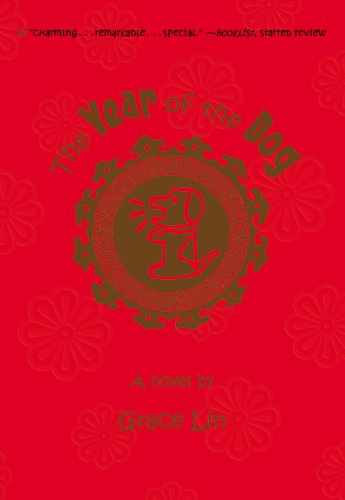
A. BIBLIOGRAPHY
Lin, Grace. 2006. THE YEAR OF THE DOG. New York, NY: Little, Brown and Company. ISBN 316060003.
B. PLOT SUMMARY
A young Taiwanese American girl, Grace, sets out to apply the lessons of the Chinese Year of the Dog, make friends and achieve goals set for herself.
C. CRITICAL ANALYSIS (INCLUDLING CULTURAL MARKERS)
Grace is a sweet character that will be enjoyed by most young girl readers. She has many of the same struggles that most adolescents have with friends, boys and family members. In addition to the regular modern day struggles, Grace uses this year to figure out more about being Taiwanese American. This book is a good example of separating out the many different Asian cultures. Lin writes about the unique characteristics of being from Taiwan and getting lumped together with all other Asian cultures. “But I’m not really Chinese either. It’s kind of confusing. My parents came from Taiwan. Some people thought Taiwan was part of China.” Luckily Grace doesn’t get bogged down in the details, she is confident that she’s the right amount Taiwanese and the right amount American. One literary element that was overused was the retelling by Grace’s mom. Every retelling session began, “Did I ever tell you about the time I…” This was too formulaic and could have been handled better.
Many cultural elements are included in the book. The book starts with the New Year celebration. Chinese is spoken to relatives to share New Year greetings, “Gong xi-gong xi!” Lin also incorporates appropriate use of special foods for these celebrations. One unique part was where Grace visits a friend’s house and doesn’t recognize the Chinese food. “Are you sure this is Chinese food?” she asks. This is a very realistic depiction because every family has a different take on special food dishes. Grace also struggles to “American enough” to have a role in the school play, Wizard of Oz, because she knows there were no Asian munchkins. Grace also criticizes the famous Chinese book, The Seven Chinese Brothers, by stating, “Those aren’t real Chinese people, your brother doesn’t have a ponytail.” This realization leads Grace to write her own book with “people like us-Chinese Americans.” Other struggles as a Chinese American are relatable to many multicultural students when Grace wants a turkey for Thanksgiving but her parents prefer fried dumplings.
The illustrations are simple pen and ink sketches that are similar to what a preteen would have in a journal. Many of the drawings are helpful to the reader because they identify different foods, like the New Year’s Tray, rice porridge and Chinese symbols. Due to the simple nature of the illustrations, all facial features are similar and very linear.
D. REVIEW EXCERPTS
APAAL Honorable Mention in Text for Children and Young Adult Literature Award
“A lighthearted coming-of-age novel with a cultural twist. Readers follow Grace, an American girl of Taiwanese heritage, through the course of one year–The Year of the Dog–as she struggles to integrate her two cultures. Throughout the story, her parents share their own experiences that parallel events in her life. These stories serve a dual purpose; they draw attention to Graces cultural background and allow her to make informed decisions. She and her two sisters are the only Taiwanese-American children at school until Melody arrives. Small, captioned, childlike black-and-white drawings are dotted throughout. This is an enjoyable chapter book with easily identifiable characters.” SCHOOL LIBRARY JOURNAL
“*Starred Review*…Most of the chapters are bolstered by anecdotes from Grace's parents, which connect Grace (and the reader) to her Taiwanese heritage. Lin does a remarkable job capturing the soul and the spirit of books like those of Hayward or Maud Hart Lovelace, reimagining them through the lens of her own story, and transforming their special qualities into something new for today's young readers.” BOOKLIST
E. CONNECTIONS
Discuss different family traditions among students. Many students probably incorporate family cultures into the “traditional American” holidays.
Learn more about Taiwan and its history.

No comments:
Post a Comment